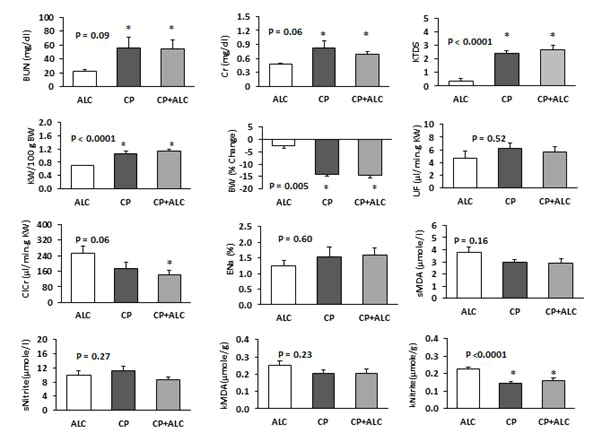Letter to Editor - Journal of Drug and Alcohol Research ( 2022) Volume 11, Issue 4
Non-Protective Effect of Alcohol in Cisplatin Induced Nephrotoxicity
Bahar Mazaheri1, Fatemeh Moslemi1, Fatemeh Emami1, Farzaneh Ashrafi1,2, Ardeshir Talebi1,3 and Mehdi Nematbakhsh1,4,5*2Department of Internal Medicine, Isfahan University of Medical Sciences, Iran
3Department of Clinical Pathology, Isfahan University of Medical Sciences, Iran
4Department of Physiology, Isfahan University of Medical Sciences, Iran
5Department of Physiology, Isfahan-MN Institute of Basic and Applied Sciences Research, Iran
Mehdi Nematbakhsh, Department of Physiology, Isfahan University of Medical Sciences, Iran, Email: nematbakhsh@med.mui.ac.ir
Received: 29-Mar-2022, Manuscript No. jdar-21-46301; Editor assigned: 31-Mar-2022, Pre QC No. jdar-21-46301 (PQ); Reviewed: 14-Apr-2022, QC No. jdar-21-46301; Revised: 19-Apr-2022, Manuscript No. jdar-21-46301 (R); Published: 26-Apr-2022, DOI: 10.4303/jdar/236171
Dear Editor
Alcohol consumption unfortunately, is more common throughout the world. Despite the prohibition of alcohol consumption in our culture, the prevalence of cancers and the side effects of anticancer drugs; cisplatin (CP) have made some unsubstantiated and unscientific propaganda based solely on opposition to religious culture to suggest alcohol consumption in preventing the side effects of anticancer drugs during cancer therapy. This short animal study was designed to investigate the protective role of alcohol consumption in CP induced nephrotoxicity.
Thirty males and females Wistar rats (205.77 ± 4.06 g) were randomly divided into 3 experimental groups of alcohol ethanol (n=9 named ALC), cisplatin (n=10, named CP) and CP+ethanol, (n=8 named ALC+CP). ALC was gavaged (3 g/kg) daily for a week. CP was injected as a single dose (7.5 mg/kg, i.p) at the first day of experiment 60 min post the first ALC administration. The ALC administration was performed daily for a week. At the end of 7th day, all the animals were placed in metabolic cage and urine samples were collected for 4 hours. Finally, biochemical and histological parameters were investigated.
A total of 8 animals were expired during the experiment. The survival time for the groups of ALC, CP and ALC+CP groups were 7.8 ± 0.2, 7.5 ± 0.4 and 7.4 ± 0.4 days with no significant difference between the groups (P=0.98). The serum level of blood urea nitrogen (BUN), creatinine (Cr) and kidney tissue damage score (KTDS) increased in group that received CP compared with ALC group. However, alcohol did not provide any protective role against these parameters (Figure 1). The clearance creatinine (ClCr) of kidney was reduced by CP, and alcohol could not return it to normal level. By examining other parameter, no protective effect for alcohol can be defined.

Figure 1: Serum level of BUN, Cr, ClCr, Urine Flow (UF), Malondialdehyde (MDA), Percentage of Na Excretion (ENa (%)), and Nitrite (sNitrite). Kidney level of MDA (kMDA) and Nitrite (kNitrite). KTDS, Body Weight (BW) and Kidney Weight (KW) changes. The star (*) indicates significant difference from ALC group (P<0.05).
Alcohol consumption causes kidney injury because of complex interaction of ethanol induced oxidative stress and pro-inflammatory alterations [1]. In addition, the results of a clinical study on women confirmed that alcohol intake, decline renal function [2]. By consuming alcohol, kidney cells damage and these changes are related to pathophysiology, perhaps, these damages is due to alcohol itself or its productions that have been induced by metabolizing alcohol like free radicals [1]. Alcohol consumption induced kidney injury is related to oxidative stress mechanism [3-5]. Furthermore, the alcohol consumption induced pathogenesis also is associated with stress oxidative, mitochondrial dysfunction, inflammation and cell death by activating apoptosis pathway [6,7]. On the other hand, CP induced nephrotoxicity is related to stress oxidative, inflammation and apoptosis [8,9]. With these explanations alcohol consumption and administration of CP get worse kidney injury, and unofficial advice from people on alcohol consumption is not evidence base, and one should not believe. However, even if it were evidence based, it would not be wise to create a contradiction in religious culture, because not all aspects of an issue may be clear to us.
Acknowledgment
None
Conflicts of Interest
No conflict of interest was declared.
References
- Z.V. Varga, C. Matyas, J. Paloczi, P. Pacher, Alcohol misuse and kidney injury: epidemiological evidence and potential mechanisms, Alcohol Res, 38(2017), 283.
[Google Scholar] [PubMed]
- E.L. Knight, M.J. Stampfer, E.B. Rimm, Hankinson SE, Curhan GC, Moderate alcohol intake and renal function decline in women: A prospective study, Nephrol Dial Transplant, 18(2003), 1549-54.
[Crossref] [Google Scholar] [PubMed]
- S.K. Das, D. Vasudevan, Alcohol-induced oxidative stress, Life Sci, 81(2007), 177-87.
[Crossref] [Google Scholar] [PubMed]
- D. Wu, Q. Zhai, X. Shi, Alcohol‐induced oxidative stress and cell responses, J Gastroenterol Hepatol, 21(2006),S26-S9.
[Crossref] [Google Scholar] [PubMed]
- E. Cikler-Dulger, I. Sogut, Investigation of the protective effects of boric acid on ethanol induced kidney injury, Biotech Histochem, 95(2020),186-93.
[Crossref] [Google Scholar] [PubMed]
- A. Havasi, S.C. Borkan, Apoptosis and acute kidney injury, Kidney Int, 80(2011), 29-40.
[Crossref] [Google Scholar] [PubMed]
- K. Dreval, A. de Conti, S. Furuya, F.A. Beland, I. Rusyn, miR-1247 blocks SOX9–mediated regeneration in alcohol-and fibrosis-associated acute kidney injury in mice, Toxicology, 384(2017), 40-49.
[Crossref] [Google Scholar] [PubMed]
- Y.C. Huang, M.S. Tsai, P.C. Hsieh, J.H. Shih, T.S. Wang, et al. Galangin ameliorates cisplatin-induced nephrotoxicity by attenuating oxidative stress, inflammation and cell death in mice through inhibition of ERK and NF-kappaB signaling, Toxicol Appl Pharmacol, 329(2017), 128-39.
[Crossref] [Google Scholar] [PubMed]
- N. Santos, C. Catao, N. Martins, C. Curti, M. Bianchi, et al. Cisplatin-induced nephrotoxicity is associated with oxidative stress, redox state unbalance, impairment of energetic metabolism and apoptosis in rat kidney mitochondria, Arch Toxicol, 81(2007), 495-504.
[Crossref] [Google Scholar] [PubMed]
Copyright: © 2022 Bahar Mazaheri, et al. This is an open access article distributed under the terms of the Creative Commons Attribution License, which permits unrestricted use, distribution, and reproduction in any medium, provided the original work is properly cited.

